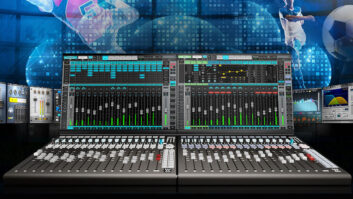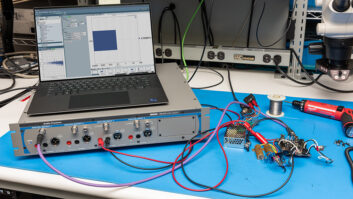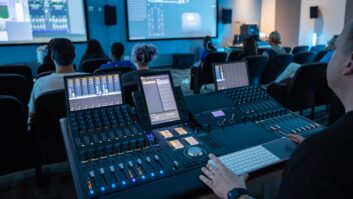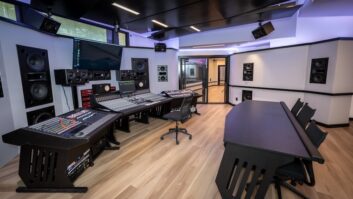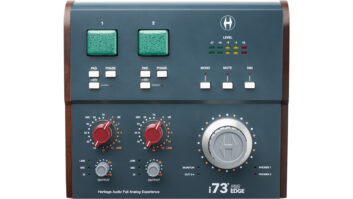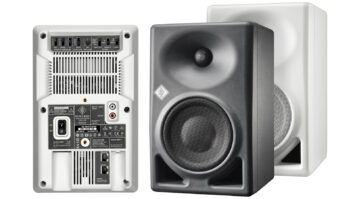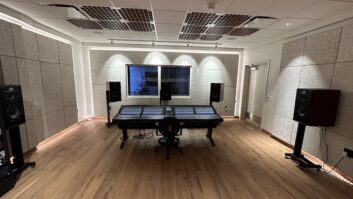Old Lyme, Conn., October 22, 2011: Over the course of his five-decade long career, George Massenburg has been a successful equipment designer and manufacturer, an internationally renowned record producer and engineer, a multi Grammy® Award winner, and a member of the National Recording Preservation Board of the Library of Congress. More recently, he has turned yet another page in his career, and is now an associate professor at Montreal’s prestigious McGill University, where he was named to the Dean’s Chair in the Schulich School of Music in 2010.
Fifty years ago, Massenburg first had the opportunity to hear a Neumann U 67 — a microphone he eventually acquired and still cherishes. Just weeks ago, he tried the new Neumann KH 120 studio monitor, which has earned a coveted spot in his daily workflow. In his role at McGill, the only university in North America to offer a Master’s and PhD degrees in sound recording, Massenburg is helping students understand the role that audio plays in a much broader context of film and multimedia.
You have accomplished so much in your career. What inspired you to take on a role as professor?
GM: In 1995, an acquaintance from Poland named Wieslaw Woszcyk contacted me. At that time, he was a young sound engineer with a degree looking for work in New York City. Eventually he found his way to Montreal to McGill University, which had — and arguably still has — the best post-graduate music and sound recording track in the world, which is modeled after a European Tonmeister degree. Over the years, McGill graduates have done very well — these are people who love sound recording before they come in and that makes all the difference. The real attraction for me in teaching is that I really learn a lot — so when the opportunity came up for me to join the faculty, the attraction was irresistible.
I came on to develop some new tracks, one of which is a formal effort in video production — something that I have been increasingly interested in for years. Here I have an opportunity to, for instance, take musicians and teach them how to be cameramen, rather than trying to train journeyman cameramen to be sensitive to music. Another of my roles is to elevate McGill in the eye and ear of the Internet — to extend the presence of McGill to the world.
What was your first experience with Neumann?
GM: The first time I held a Neumann microphone was in 1961, when I was invited to come and see a friend’s studio. It was Deane Jensen, and I was just 14 years old. Listening to early stereo recordings played from an Ampex 300 through Beyer DT48 headphones transmuted my genes right there on the spot, and that’s when I knew I had to record music. It was all about picking microphones and listening to different positions for them. We had a couple of Neumann U 67s, U 48s, KM 56s and others. That was my first introduction to recording, through Neumann many years ago.
Where do the new Neumann KH 120 studio monitors fit into your world now?
I like the Neumann KH 120 studio monitors; they fill an empty niche in my workflow. They are so small that I can pack them for the road, and set them up just about anywhere and really get a sense of a mix. With the KH 120s, an Apple® MacBook Pro 17, my DAW, Prism converters, and a portable work surface, I can do a pretty darn pro mix in a hotel room — I have not been able to do that easily until now. Recently, I’ve been mixing the McGill Opera production of La Bohéme on them — a big, high-definition show — and found them to be very relatable to the outside world.
What are some of the sonic attributes you appreciate in the KH 120s?
First and foremost, they are flat and transparent. But the size is what makes them a real winner. I don’t need to have a wall of monitors driven by 10,000 watts of power — these are all that I need. They are just heavy enough to give me punch in the low end, and they speak evenly at both high and low levels.
What are the benchmarks you consider when evaluating a studio monitor?
A couple of things: First a studio monitor should be flat, but at the same time fill a room (if there’s an artist or outside producer present you’ll want to impress them). Better monitors will have a tight center image, along with even dispersion, transparency (the ability to hear subtleties in the presence of loud stuff), and flatness through the crossover region. Both speakers in a pair need to be well matched so it sounds like one speaker. I liked the crossover of the original Klein and Hummels a lot, and the Neumann KH 120 is a very nice improvement on this — it is very well designed and tooled. The stereo imaging was also great in the Klein and Hummels, and it is even better in the Neumann KH 120s. The center is dead center.
How important is it to have a common reference point when monitoring?
If you’re used to going into the same, big control room and listening to your work on the wall or on near-fields, they’re a basis for your choices — a reference. But often these days we’re going into a musician’s-poor-excuse-for-a-studio, and we need near-fields that we can really depend on — although you’ll have to deal with the often-poor acoustics of the room, and maybe pull the monitors in close so the room doesn’t contribute too much to what you’re hearing. But if you can take monitors that you like to this sort of gig, you’ll have a much better idea of what you’ve got. This is exactly the niche that the KH 120s fill for me — they do pretty much everything that I need them to do.
Having run a successful equipment company, what is your perspective on the importance of maintaining integrity throughout the manufacturing process?
What you always worry about after you hear a great product is whether a company will decide to mass-produce it at a low cost, possibly in an inferior manufacturing environment. That’s never going to happen with Neumann and Sennheiser — these companies are still all about quality and carrying this throughout the manufacturing process. Speaker serial numbers 10,001 and 10,002 will sound as good as the pair that I have.
